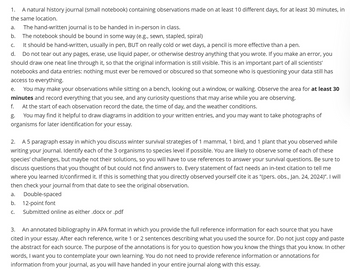
Applications and Investigations in Earth Science (9th Edition)
9th Edition
ISBN: 9780134746241
Author: Edward J. Tarbuck, Frederick K. Lutgens, Dennis G. Tasa
Publisher: PEARSON
expand_more
expand_more
format_list_bulleted
Question

Transcribed Image Text:1.
A natural history journal (small notebook) containing observations made on at least 10 different days, for at least 30 minutes, in
the same location.
a. The hand-written journal is to be handed in in-person in class.
b.
The notebook should be bound in some way (e.g., sewn, stapled, spiral)
C.
It should be hand-written, usually in pen, BUT on really cold or wet days, a pencil is more effective than a pen.
d.
Do not tear out any pages, erase, use liquid paper, or otherwise destroy anything that you wrote. If you make an error, you
should draw one neat line through it, so that the original information is still visible. This is an important part of all scientists'
notebooks and data entries: nothing must ever be removed or obscured so that someone who is questioning your data still has
access to everything.
e. You may make your observations while sitting on a bench, looking out a window, or walking. Observe the area for at least 30
minutes and record everything that you see, and any curiosity questions that may arise while you are observing.
f.
g.
At the start of each observation record the date, the time of day, and the weather conditions.
You may find it helpful to draw diagrams in addition to your written entries, and you may want to take photographs of
organisms for later identification for your essay.
2.
A 5 paragraph essay in which you discuss winter survival strategies of 1 mammal, 1 bird, and 1 plant that you observed while
writing your journal. Identify each of the 3 organisms to species level if possible. You are likely to observe some of each of these
species' challenges, but maybe not their solutions, so you will have to use references to answer your survival questions. Be sure to
discuss questions that you thought of but could not find answers to. Every statement of fact needs an in-text citation to tell me
where you learned it/confirmed it. If this is something that you directly observed yourself cite it as "(pers. obs., Jan. 24, 2024)”. I will
then check your journal from that date to see the original observation.
a.
Double-spaced
b. 12-point font
C. Submitted online as either .docx or .pdf
3.
An annotated bibliography in APA format in which you provide the full reference information for each source that you have
cited in your essay. After each reference, write 1 or 2 sentences describing what you used the source for. Do not just copy and paste
the abstract for each source. The purpose of the annotations is for you to question how you know the things that you know. In other
words, I want you to contemplate your own learning. You do not need to provide reference information or annotations for
information from your journal, as you will have handed in your entire journal along with this essay.
SAVE
AI-Generated Solution
info
AI-generated content may present inaccurate or offensive content that does not represent bartleby’s views.
Unlock instant AI solutions
Tap the button
to generate a solution
to generate a solution
Click the button to generate
a solution
a solution
Knowledge Booster
Recommended textbooks for you
 Applications and Investigations in Earth Science ...Earth ScienceISBN:9780134746241Author:Edward J. Tarbuck, Frederick K. Lutgens, Dennis G. TasaPublisher:PEARSON
Applications and Investigations in Earth Science ...Earth ScienceISBN:9780134746241Author:Edward J. Tarbuck, Frederick K. Lutgens, Dennis G. TasaPublisher:PEARSON Exercises for Weather & Climate (9th Edition)Earth ScienceISBN:9780134041360Author:Greg CarbonePublisher:PEARSON
Exercises for Weather & Climate (9th Edition)Earth ScienceISBN:9780134041360Author:Greg CarbonePublisher:PEARSON Environmental ScienceEarth ScienceISBN:9781260153125Author:William P Cunningham Prof., Mary Ann Cunningham ProfessorPublisher:McGraw-Hill Education
Environmental ScienceEarth ScienceISBN:9781260153125Author:William P Cunningham Prof., Mary Ann Cunningham ProfessorPublisher:McGraw-Hill Education Earth Science (15th Edition)Earth ScienceISBN:9780134543536Author:Edward J. Tarbuck, Frederick K. Lutgens, Dennis G. TasaPublisher:PEARSON
Earth Science (15th Edition)Earth ScienceISBN:9780134543536Author:Edward J. Tarbuck, Frederick K. Lutgens, Dennis G. TasaPublisher:PEARSON Environmental Science (MindTap Course List)Earth ScienceISBN:9781337569613Author:G. Tyler Miller, Scott SpoolmanPublisher:Cengage Learning
Environmental Science (MindTap Course List)Earth ScienceISBN:9781337569613Author:G. Tyler Miller, Scott SpoolmanPublisher:Cengage Learning Physical GeologyEarth ScienceISBN:9781259916823Author:Plummer, Charles C., CARLSON, Diane H., Hammersley, LisaPublisher:Mcgraw-hill Education,
Physical GeologyEarth ScienceISBN:9781259916823Author:Plummer, Charles C., CARLSON, Diane H., Hammersley, LisaPublisher:Mcgraw-hill Education,

Applications and Investigations in Earth Science ...
Earth Science
ISBN:9780134746241
Author:Edward J. Tarbuck, Frederick K. Lutgens, Dennis G. Tasa
Publisher:PEARSON

Exercises for Weather & Climate (9th Edition)
Earth Science
ISBN:9780134041360
Author:Greg Carbone
Publisher:PEARSON

Environmental Science
Earth Science
ISBN:9781260153125
Author:William P Cunningham Prof., Mary Ann Cunningham Professor
Publisher:McGraw-Hill Education

Earth Science (15th Edition)
Earth Science
ISBN:9780134543536
Author:Edward J. Tarbuck, Frederick K. Lutgens, Dennis G. Tasa
Publisher:PEARSON

Environmental Science (MindTap Course List)
Earth Science
ISBN:9781337569613
Author:G. Tyler Miller, Scott Spoolman
Publisher:Cengage Learning

Physical Geology
Earth Science
ISBN:9781259916823
Author:Plummer, Charles C., CARLSON, Diane H., Hammersley, Lisa
Publisher:Mcgraw-hill Education,